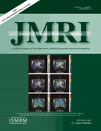Sinusoidal echo-planar imaging with parallel acquisition technique for reduced acoustic noise in auditory fMRI
Abstract
Purpose:
To extend the parameter restrictions of a silent echo-planar imaging (sEPI) sequence using sinusoidal readout (RO) gradients, in particular with increased spatial resolution. The sound pressure level (SPL) of the most feasible configurations is compared to conventional EPI having trapezoidal RO gradients.
Materials and Methods:
We enhanced the sEPI sequence by integrating a parallel acquisition technique (PAT) on a 3 T magnetic resonance imaging (MRI) system. The SPL was measured for matrix sizes of 64 × 64 and 128 × 128 pixels, without and with PAT (R = 2). The signal-to-noise ratio (SNR) was examined for both sinusoidal and trapezoidal RO gradients.
Results:
Compared to EPI PAT, the SPL could be reduced by up to 11.1 dB and 5.1 dB for matrix sizes of 64 × 64 and 128 × 128 pixels, respectively. The SNR of sinusoidal RO gradients is lower by a factor of 0.96 on average compared to trapezoidal RO gradients.
Conclusion:
The sEPI PAT sequence allows for 1) increased resolution, 2) expanded RO frequency range toward lower frequencies, which is in general beneficial for SPL, or 3) shortened TE, TR, and RO train length. At the same time, it generates lower SPL compared to conventional EPI for a wide range of RO frequencies while having the same imaging parameters. J. Magn. Reson. Imaging 2012;36:581–588. © 2012 Wiley Periodicals, Inc.




